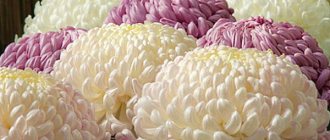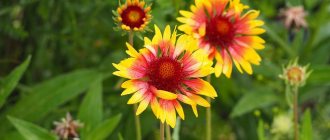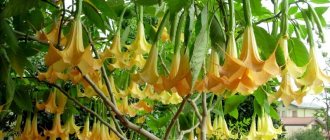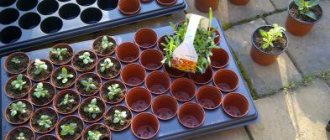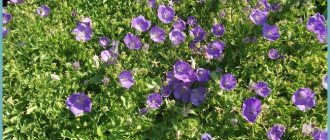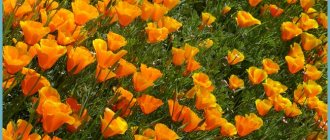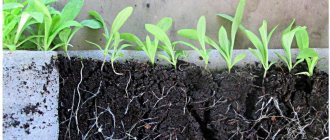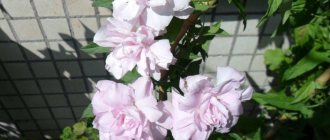The most common plant in landscape design today remains the unpretentious and hardy soft cuff - an amazing and unique creation of nature. Believe me, the appearance of this amazing plant in your garden will make the overall picture simply charming. In order for you to be able to grow soft cuffs on your own site, we will give several recommendations and reveal the main secrets: we will introduce the main varieties, talk about planting in open ground, as well as the main points of proper care.
Soft cuff: varieties and varieties
Perennial soft cuffs have a large root system, and the height of the crop reaches 35-40 cm. The leaves of the plant are simply magnificent: they are fan-shaped and taper towards the base. After the rain, you can see how incredibly beautiful small droplets collect on them. In addition, through the stomata, the leaves of the soft cuffs release excess moisture, which is located in drops along the edge of the leaf plate. The flowers of the plant are small, collected in fluffy paniculate inflorescences. Its flowering period lasts from June to August, but sometimes it can bloom again in September.
If you want to decorate your garden with a green carpet, plant a cuff
This genus of plants has a huge number of species, but they are all very similar to each other. There are the following main types of cuff:
- The cuff is soft. The flowers of this species are quite small and green-yellow in color. The most famous variety is Robusta (fast-growing, wild-like).
Soft cuff - Alpine cuff. The lobed leaves of these plants create peculiar hummocks on which yellow small flowers appear in the summer. All their decorative value lies precisely in the dark green leaves.
Alpine cuff - Hoppe cuff. A very miniature type of cuff, similar to an alpine one. Hoppe cuff
- Siberian cuff. Grows in Siberian meadows. These perennial plants have thick roots and reach 30 cm in height. Their kidney-shaped leaves are pubescent on both sides.
Siberian cuff
Due to their stunning appearance, they are all actively used in modern landscape design.
Medicinal properties
As you may have already noticed, the cuff has a number of substances useful for the body, and based on this, its beneficial properties appear.
For example, residents of Denmark value the herb for its positive effect on diseases of the gastrointestinal tract (gastrointestinal tract), in particular, it perfectly heals ulcers and gastritis.
Italians use it to treat long-term dyspepsia, painful urination, and poor sleep.
White sandman - medicinal properties, uses and recipes from traditional medicine (video + 90 photos)Dubrovnik - beneficial properties of the plant and tips on collecting and choosing herbs (95 photos and videos)
- Smoker officinalis - recipes, use in folk medicine, description of the properties and medicinal qualities of the plant (110 photos)
People in our country weld the cuff and treat themselves with:
- Elevated temperature.
- Severe headache.
- General malaise.
- In stressful situations
The healing properties of the cuff are described in many medical sources and fully confirm the onset of the effect of its use. That's why she has so many fans.
Planting a cuff in open ground
The soft cuff will surprise you with its fantastically beautiful leaves. Planting and caring for it is quite simple, since it is an unpretentious and well-growing crop.
These perennials are best grown in soft, indirect sunlight and afternoon shade. Loose, soft soils rich in humus will be favorable for planting.
The cuff takes root well and does not cause any trouble for the gardener
Planting is done in moist open ground. To make the plant develop more actively, humus and compost can be added to the soil. The distance between seedlings should be about 30 cm, since the soft mantle grows very quickly, and the process of transplanting it is quite complicated (due to the peculiarities of the root system).
Description and characteristics
When you first look at this flower, what immediately catches your eye are its leaves, which are shaped like a small cuff. At the edge of each leaf tooth there is a small drop of dew, in the middle there is a larger drop of dew, in the form of a sparkling pearl.
This appearance of each leaf individually is the reason why this plant is popularly called the Tear of God. Dew drops are moisture that is released through the mouth of the leaf blade. This plant ability is called guttation.
The flowers of the Cuff are small, greenish-yellow in color and collected in a panicle inflorescence. The flowering period lasts from May to July. The height of the plant does not exceed 50 - 60 cm. The root system is extremely larger than the ground part.
The cuff is popular among many gardeners due to its unpretentiousness and ease of care. In addition, the crop propagates very well by seeds.
The plant goes well with almost all types of herbs and flowers. Choosing a place to plant the Cuff will not cause any particular difficulties: both a well-lit place and partial shade are suitable for this. You can find flowers in bright forest clearings, meadows or on the side of roads throughout Europe.
Plant care
To ensure that growing soft cuffs brings you excellent results, you should follow a few simple rules and care tips:
- at the end of the flowering period, caring for these plants involves cutting off yellow leaves and inflorescences;
- in the fall, the plants are mulched with peat or fallen leaves (this will help the cuffs easily endure the cold winter season).
Be sure to cover the cuff before the onset of winter cold
Attention! Excessive watering of the plant can cause root rot. Provide the soft cuff with a good drainage system.
Planting and care on the site
As mentioned earlier, Cuff is unpretentious in cultivation and easy to propagate.
The plant feels good not only in well-lit areas, but also in partial shade. If the Cuff grows in a sunny place, it needs additional watering. In shady places there is no need to water the plant additionally; it only needs moisture supplied in the form of precipitation.
For active growth, the plant needs loose, humus-fertilized soil with a low soil pH (up to 6%).
In order for the crop to form young shoots, it is necessary to periodically remove old and yellowed pagons. If the leaves of the Cuff begin to turn yellow or wilt, this means that the soil needs to be fertilized a little. It has the ability to grow in one place for many years.
The grass tolerates low winter temperatures well and does not require additional insulation. It is important not to forget that the Cuff does not tolerate stagnant water. This is worth paying attention to.
Cuff Reproduction
Reproduction of the soft cuff can be done using two methods:
- sowing seeds;
- dividing the bush.
Dividing a cuff bush
Propagation of these perennial plants by dividing the bush is carried out in spring or autumn. The bush is carefully dug up, divided and planted in new places.
Advice. It is best to propagate soft cuff varieties by seeds. The plant has a large and densely woven root system. Digging it out of the ground is quite labor-intensive; in addition, the rhizome can be damaged.
Seeds are sown in well-moistened soil. After just a year, the seedlings can be moved into open ground and further grown there. The optimal time for sowing will be late autumn.
Where and how does it grow
The plant produces a lot of small seeds, so it grows well in the wild. The most active flowering is observed in July-August. The plant reproduces by self-seeding and through the root system.
The cuff is spread quite widely. It can be found in all CIS countries. Most often it grows in sparse forests, on river banks and meadows. It is also often grown in gardens as decorative ornaments and for further use in folk medicine.
Diseases and pests
Fortunately, this plant is quite disease resistant. Improper care of the soft cuff often leads to the appearance of powdery mildew on it. When planted under trees, it may be affected by black rust. Also, the leaves of the plant can be damaged by snails or slugs.
Very often the cuff is attacked by snails
High humidity and lack of sun often cause mold to appear on the stems and leaves of the soft mantle. Transplanting the plant to a suitable place and treating it with fungicidal preparations will help get rid of this.
Composition of grass
The cuff is very rich in vitamins and other useful microelements. It contains:
- Vitamin E.
- Ascorbic acid.
- Zinc, copper and molybdenum.
- Sahara.
- Tannins.
Previously, the complete pharmacological composition of the cuff was described in a medical textbook dating back to 1835 by a professor from St. Petersburg.
Elderly people use a pressure cuff and I consider it the best remedy for this.
In Tsarist Russia, doctors prescribed cuff tinctures to patients to strengthen the immune system and improve performance.
Soft cuff: combination with other plants
In landscape design, soft cuffs are often used in combination with other plants. Many cultures harmonize perfectly with it. For example, wonderful combinations are formed from soft mantle and white daisies, blue cornflowers, red heucheras, blue delphiniums, etc. They create a very bright decorative cover that requires virtually no maintenance.
Cuff in landscape design
Collection and storage
For medicinal purposes, the mantle is harvested all summer while the plant is blooming. The entire plant is used - stems, leaves, flowers. But you only need to collect dry material. Then it is left to dry in a ventilated room or electric dryer at 60 degrees, no more. Raw materials dried in this way have a bitter and tart taste.
Dried cuff herb should be stored in a glass container, fabric or paper bags for no more than a year, otherwise the raw material will become even more bitter.
Soft cuff in landscape design
It is difficult to even imagine modern landscape design without the use of various varieties of cuff. In flower beds, it perfectly smooths out sharp transitions between different bright colors and is a “welcome guest” in plantings of a pastel palette of shades. It is not recommended to place it along the contour of the lawn. It is best to plant soft cuff in the foreground of flower beds that are adjacent to paths or ponds. In addition, it is often used in ceremonial compositions. This plant can easily decorate rock gardens, alpine slides, and ridges.
Contraindications and side effects
There are very few contraindications:
- children under 2 years old
- individual intolerance
- disturbance of intestinal motility
- be careful during pregnancy
Side effects occur extremely rarely, mainly in the form of allergic reactions on the skin.
The cuff has many medicinal properties, but its rich composition allows it to be used for prevention. Therefore, it will be useful for people of different ages and health conditions.


